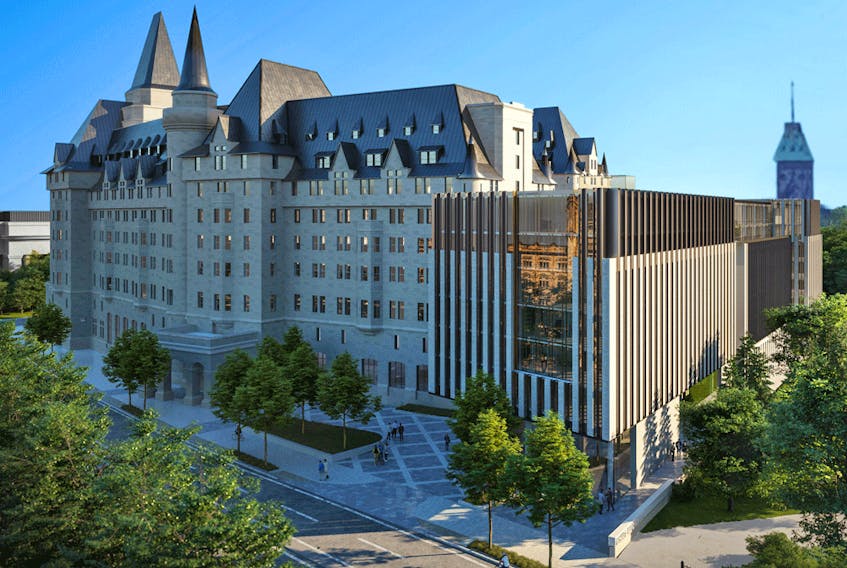OTTAWA — Under normal circumstances, a three-year planning dispute in Ottawa wouldn’t make the national news.
But when it involves the landmark Chateau Laurier hotel, the turreted jewel of the postcard landscape alongside the Parliament buildings and the Rideau Canal, the stakes get higher.
“This is going to, as it currently stands, disfigure an iconic, famous, important, beautiful scene at the heart of our capital city,” said Peter Coffman, an architectural historian and professor at Carleton University. “And I honestly can’t think of another country in the world, at least not one that I’ve ever visited, that would allow this to happen.”
The battle is over an addition to the back of the Chateau Laurier that would add 147 hotel rooms. But while the main part of the hotel, built in 1912 and expanded in 1927, is in the French chateau style — with towers and turrets and steep copper roofs — the addition is designed as a modern-style box. Critics have variously described it as a “shipping container,” a “radiator,” and an “air-conditioning unit.”
When the proposed addition was unveiled in 2016, it was met with widespread public outrage. Since then it’s gone through five revisions and been reduced from 12 storeys to seven. Ottawa city staff say the latest edition meets all the established criteria.
But city council is still deeply divided over the issue, and next week it will vote on whether to revoke the addition’s heritage permit. It may be the last chance for elected politicians to formally weigh in on the matter.
Dennis Jacobs, a former director of planning with the City of Ottawa, was hired to manage the addition by the hotel’s ownership, Larco Investments. Jacobs points to the fact the hotel used to have a parking garage and service facilities out back, and argues the new addition merges better with the park behind it while leaving the front view of the hotel unchanged.
“People don’t necessarily like change, and certainly not dramatic change,” Jacobs said in an interview. “What they want to see is a replica Disneyland version of the hotel. We can’t give them Disneyland, but they still want it. We’re giving what national heritage guidelines provide direction on in creating a compatible, subordinate addition to the hotel.”
Jacobs said many people don’t understand that despite its location, the hotel is private property. “While it is a publicly loved and cherished building, it is privately owned, privately managed, and it was acquired without any public money,” he said.

The backlash has been intensifying as the addition moves closer to final approval. Last week, Ottawa architect Barry Padolsky — a member of the city’s built-heritage subcommittee — wrote an open letter to Prime Minister Justin Trudeau, urging him to intervene in “this imminent act of visual vandalism in the heart of our Capital.”
“The proposed architectural design has horrified many Canadians for its unsympathetic visual impact on the picturesque heritage values of the Chateau Laurier, a National Historic Site,” Padolsky wrote.
Planning issues are never simple in downtown Ottawa, thanks primarily to the National Capital Commission, the federal Crown corporation that manages swaths of property throughout the region, including the Rideau Canal. The NCC is “dedicated to ensuring that Canada’s Capital is a dynamic and inspiring source of pride for all Canadians, and a legacy for generations to come,” its website says.
Yet the NCC’s position in the Chateau Laurier debate has been to stay hands off, insisting it’s a municipal issue. Heritage Minister Pablo Rodriguez, the cabinet minister overseeing the NCC, supports its position.
“Let’s be honest, I would have done the design differently, and I think people in Ottawa are on the same page,” Rodriguez said in a statement. “That being said, the National Capital Commission has no responsibility or authority over private lands and it is an independent Crown Corporation. This is primarily a municipal issue that needs to be managed by the municipality.”
Environment Minister Catherine McKenna, who’s from a downtown Ottawa riding and oversees Parks Canada, was not reachable on Wednesday. But her office said Parks Canada fulfilled its role to give input to the city on how the addition affects the Chateau’s status as a National Historic Site.
“In response to the most recent design, Parks expressed some concerns with the addition’s impacts on the visual setting,” McKenna’s office said.
That leaves it up to city council. But last year the council’s built-heritage subcommittee essentially delegated the file to city staff, giving the addition conditional approval once staff signed off on elements such as changing the window pattern and adding more limestone.
Coun. Mathieu Fleury is making a last-ditch effort to have council vote on revoking the heritage permit, scheduled for July 10. Larco Investments is threatening “costly litigation” if that happens.
Fleury said he believes the elected councillors must vote on this, otherwise they’re “hiding behind process” to avoid an unpopular issue. He said he thinks public opinion is running 90 per cent opposed to the addition, if not higher.
Coffman, the architectural historian, sighs at all of this. “Avoidance of responsibility seems to be the default position of our whole political system,” he said. “City council being perhaps the best example of that, where they essentially accepted the current design sight unseen and downloaded the responsibility for that onto city staff.”
This is not just about disliking change, Coffman said. “There are ways to make a new addition to an old building compatible,” he said. “This design, and frankly all the versions of this design, have ignored all those ways and just gone off and done its own thing.”
Jacobs said the hotel’s ownership has done everything required of them, and the design isn’t changing.
“It is the final one because we went through a process directed by city council to work with their staff and get their staffs approval,” he said. “We achieved all of the milestones that were set forth. And that was all done with the public opinion that was out there.”
• Email: [email protected] | Twitter: btaplatt
Copyright Postmedia Network Inc., 2019









